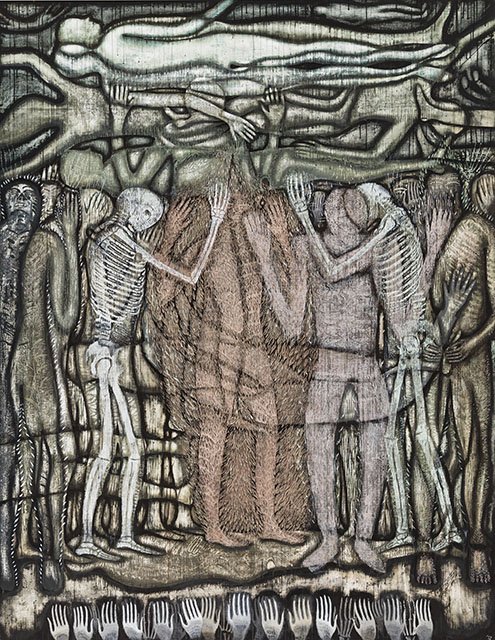Peter Graham
Peter Graham
Australian, born 1970
Uprising 2008
oil, woodcut and charcoal on canvas
Geelong Gallery
Gift of Geoffrey Smith and Gary Singer through the Australian Government's Cultural Gifts Program, 2019
© Courtesy of the artist
Peter Graham’s work since the early 1990s has been distinguished by a highly original, lyrical figuration in which he seeks to give form to emotional and physical human states that oscillate between the mundane and the mystical. Many of his early works represented solitary figures in dark landscapes, or indeterminate spaces that poetically implied chambers of the mind, or the layered or compartmentalised spaces of memory. While Graham stated in 2018 that the ‘origins of a picture emerge unexpectedly’ his images reflect his profound feeling for human beings’ fundamental relationship to the earth and the biodiverse world. In formal terms his works are visually empowered by his exceptional command of painting, drawing and printmaking techniques that he routinely combines in a single work, as he does with Uprising.
This large-scale, multi-layered painting is from Graham’s ‘Deliverance’ series, a body of work that was inspired by crowd-surfing revellers at live music events. The vision of bodies elevated and supported by the crowd below—and transported more often than not to a position of safety towards the stage—is one that Graham translates here to address concepts of ‘transcendence and the emancipation of the spirit from the body’.
As the artist has elaborated: ‘The works describe the passage of the spirit from an ‘earth state’ to an atmosphere aloft and the physics of this delivery’.
Graham continues: ‘Above the lower crowd is a ceremonial body of mythic beings. These figures are a frieze of effigies and are projected deliberately flat upon the picture-plane. Perhaps they are the higher consciousness of the individuals beneath, a league of magicians operating on a level just beyond physical reach.’
The repetition of horizontal forms reinforces the concept of elevation, whilst the artist’s working process results in an exquisitely detailed surface that conveys the spiritual essence of the figures. Working with oil paint, charcoal and the woodcut process, Graham describes the process of ‘rubbing back through less resistant layers [to expose] underlying marks to give the figures various degrees of corporeality. It was in this way that I hoped to attain the feeling of the body as a scar, a mere trace of a physical presence.’



